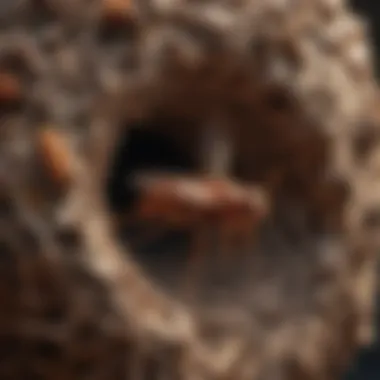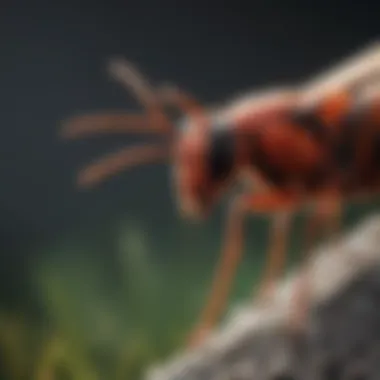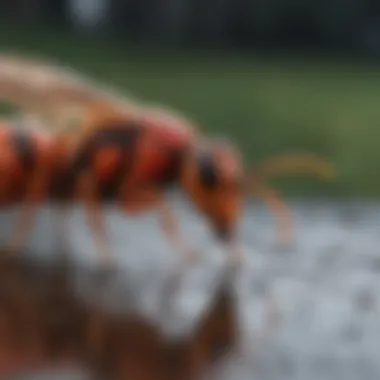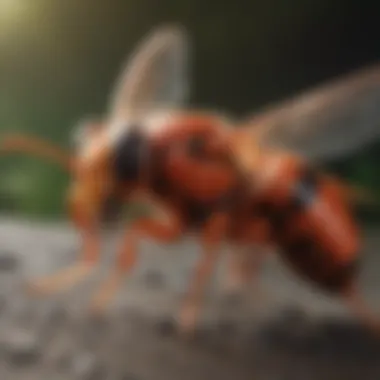Expert Strategies for Red Wasp Removal and Prevention


Preventive Pest Control Strategies
When considering preventive pest control strategies, it is essential to focus on various aspects to ensure a pest-free environment. Beginning with house exterior protection, one must pay close attention to sealing cracks effectively to prevent easy entry for pests. Additionally, clearing debris around the property is crucial as it eliminates potential hiding spots for pests and reduces the attractiveness of the area for infestations to occur. Moreover, implementing methods to prevent pests from entering the home, such as installing proper screens on doors and windows, can significantly reduce the risk of invasion.
Yard maintenance plays a vital role in pest control as well. Establishing essential yard care routines, including regular mowing, trimming shrubs, and removing standing water sources, can create an inhospitable environment for pests. Furthermore, utilizing methods like natural pest repellents and eco-friendly pesticides can help in maintaining a pest-free yard.
Indoor cleanliness is another key element in pest prevention. Adopting expert cleaning tips and techniques, such as regularly vacuuming, proper food storage, and sealing cracks around baseboards, can deter pests from establishing themselves indoors. Similarly, keeping a pest-resistant indoor environment involves maintaining a clutter-free space, reducing moisture levels, and promptly fixing any plumbing issues.
Efficient garbage disposal is crucial in pest control. By implementing proper waste disposal methods, such as sealing trash cans tightly, disposing of food waste promptly, and cleaning trash receptacles regularly, one can significantly minimize the attractiveness of the home to pests. Emphasizing the importance of proper garbage disposal practices can ultimately contribute to a pest-free environment.
Lastly, innovative pest prevention strategies can offer additional layers of protection for the home. This may include using natural deterrents like peppermint oil or cinnamon sticks, investing in ultrasonic pest repellents, or considering professional pest control services for regular inspections and treatments to ward off potential infestations.
Understanding Red Wasps
Red wasps are a prevalent type of wasp known for their distinct appearance and behavior that can pose risks to human health and property. Understanding red wasps is crucial in effectively addressing infestations and mitigating potential dangers they may bring. By delving deep into their habits, nesting preferences, and foraging patterns, individuals can equip themselves with the knowledge required to tackle red wasp problems head-on.
Identification of Red Wasps
Red wasps can be identified by their vibrant red coloring and slender body structure, making them easily distinguishable from other wasp species. Their striking appearance serves as a warning signal due to their potent stinging capabilities. Nesting habits play a significant role in identifying red wasp colonies, as they often build paper-like nests under eaves, in attic spaces, or underground. Understanding these key characteristics of red wasps' physical appearance and nesting behaviors is crucial for effective management and control strategies.
Physical Appearance
The physical appearance of red wasps is marked by their reddish-orange hues, slim waists, and distinctive wings that fold lengthwise when at rest. These features make them stand out in comparison to other wasp species and signal their potential threat due to their venomous sting. While their striking appearance may seem visually appealing to some, it is essential to recognize that these attributes also serve as a cautionary indication of their potential danger.
Nesting Habits
Red wasps exhibit a preference for building nests in protected areas, such as within wall voids, shrubs, or abandoned structures. Their characteristic oval-shaped nests, constructed from a paper-like material chewed and formed into place by the wasps, signify their presence in the vicinity. Although their nesting habits showcase their resourcefulness, they can lead to conflicts when located near human-inhabited spaces. Understanding these nesting tendencies aids in identifying and addressing red wasp populations effectively.
Behavioral Patterns
Red wasps display distinct behavioral patterns that influence their interactions with their environment and potential threats they may pose. Their aggressive nature and foraging behaviors impact their surroundings and interaction with humans, necessitating a deeper understanding for successful red wasp control measures.


Aggressiveness
The aggressiveness of red wasps stems from their territorial instincts and defense mechanisms when provoked. They exhibit a rapid response to perceived threats, often defending their nests vigorously against intruders. This aggressive behavior underscores the importance of caution when dealing with red wasps to avoid potential stings and confrontations. While their aggressiveness can be viewed as a natural defense mechanism, it requires careful handling to prevent conflicts.
Foraging Behaviors
Red wasps engage in active foraging behaviors to gather food sources for their colonies, primarily preying on insects for sustenance. Their efficient foraging strategies, characterized by swift movements and targeted hunting, contribute to the maintenance of their colonies and livelihood. By understanding the foraging patterns of red wasps, individuals can implement preventative measures to minimize their attraction to human-inhabited areas and reduce potential encounters that may lead to stings. Overall, comprehending these behavioral patterns is essential in devising effective strategies for red wasp management and control.
Risk Factors and Dangers
When it comes to effectively addressing red wasp infestations, understanding the risk factors and potential dangers involved is crucial. This section delves into the various aspects that make red wasps a significant concern, shedding light on the implications for human health and property integrity.
Stings and Allergic Reactions
Impact on Human Health
Unraveling the impact of red wasp stings on human health unveils a complex interplay between venom toxicity and individual allergic responses. The potent venom injected by red wasps can trigger mild to severe reactions, ranging from localized pain and swelling to life-threatening anaphylaxis. Understanding the nuances of these reactions is essential for prompt and effective intervention strategies.
Potential Risks
The potential risks associated with red wasp encounters extend beyond immediate physical harm. Delving deeper into these risks reveals not only the direct implications of stings but also the indirect consequences on well-being and daily activities. By highlighting these risks, individuals can grasp the importance of proactive measures to mitigate red wasp-related dangers.
Property Damage
Red wasp infestations pose not only a threat to human health but also significant risks to property structures and agricultural settings. This section explores the structural concerns and agricultural damage that can arise from unchecked red wasp presence, emphasizing the need for comprehensive pest management strategies.
Structural Concerns
Examining the structural concerns linked to red wasp infestations unravels the potential havoc these insects can wreak on buildings and outdoor spaces. From nesting habits that compromise structural integrity to the debris accumulated over time, the impact of red wasps on property conditions requires vigilant monitoring and action.
Agricultural Damage
The implications of red wasp activity on agricultural settings are multifaceted, encompassing issues like crop damage, pollination disruption, and overall ecosystem imbalance. By pinpointing the specific damages inflicted by red wasps in agricultural landscapes, this section underscores the importance of tailored pest control approaches to safeguard agricultural resources.


Preventive Measures
Preventive measures are crucial in effectively managing red wasp infestations. By addressing potential issues proactively, homeowners can reduce the risk of infestations and ensure a safer environment for their families. In this article, we delve into specific elements of preventive measures, outlining their benefits and considerations in combating red wasp problems.
Environmental Modifications
Eliminating Attractive Food Sources
When it comes to eliminating attractive food sources, it is essential to understand the key role they play in attracting red wasps. These sources can include open garbage bins, fallen fruits, or pet food left outside. By removing such temptations, homeowners can significantly decrease red wasps' interest in nesting nearby. The unique feature of eliminating attractive food sources lies in its ability to disrupt the red wasps' foraging patterns, forcing them to seek sustenance elsewhere. While this approach has clear advantages in deterring red wasps, it may require consistent monitoring to ensure effectiveness.
Sealing Entry Points
Sealing entry points is another vital aspect of preventing red wasp infestations. Red wasps often enter homes through small openings or gaps in walls, windows, or doors. By meticulously sealing these entry points, homeowners can create a barrier that restricts the insects' access to indoor spaces. The key characteristic of sealing entry points is its ability to fortify the home's defenses against red wasps effectively. This method is a popular choice due to its non-invasive nature and long-term impact on reducing infestation risks. While sealing entry points offers notable benefits, homeowners should regularly inspect and maintain these seals to ensure continued protection.
Regular Inspections
Early Detection Methods
Early detection methods are instrumental in catching red wasp infestations before they escalate. By actively monitoring outdoor spaces and inspecting for signs of nesting, homeowners can identify red wasp activity early on. The key characteristic of early detection methods is their capacity to nip potential infestations in the bud, preventing widespread colonization. This approach is beneficial for its proactive nature, allowing homeowners to address red wasp issues promptly. However, early detection methods require consistent vigilance and knowledge of red wasp behaviors to be effective.
Monitoring Techniques
Monitoring techniques aid in tracking red wasp movements and population growth, providing insights into infestation patterns. By strategically placing traps or observing high-traffic areas, homeowners can gather data on red wasp activities. The key characteristic of monitoring techniques is their ability to offer tangible data for assessing the severity of red wasp infestations. This method is a popular choice for its empirical approach to pest management, allowing for targeted intervention strategies. While monitoring techniques can be informative, homeowners must interpret the data accurately and adapt their control methods accordingly.
Natural Remedies
In the realm of red wasp management, natural remedies play a vital role in maintaining a balance between efficacy and safety. Within the context of this article, natural remedies offer an environmentally friendly approach to red wasp control that appeals to those seeking non-toxic solutions. Their significance lies in providing practical alternatives to chemical-based extermination methods, promoting eco-conscious practices and reducing potential harm to surrounding ecosystems. Embracing natural remedies aligns with a sustainable living ethos while addressing pest infestations effectively.
Essential Oils and Plants
Lavender Oil
Lavender oil, a prominent component of natural pest control, stands out for its aromatic properties and insect-repelling qualities. It serves as a soothing agent while deterring red wasps due to its strong scent, making it a popular choice for combating these pests naturally. The key characteristic of lavender oil lies in its multipurpose functionality, not only as a pest repellent but also for its calming effects on humans. Utilizing lavender oil in this context offers a dual advantage of pest management and promoting relaxation in the environment. Despite its efficacy, some may find the strong fragrance of lavender oil overwhelming, which could be a drawback in sensitive situations.


Mint Plants
Mint plants constitute another powerful weapon in the arsenal of natural remedies against red wasps. Known for their strong scent and flavorful leaves, mint plants serve as excellent deterrents for various pests, including red wasps. The key characteristic of mint plants is their easy cultivation and maintenance, making them a practical choice for those looking to incorporate natural repellents in their surroundings. Mint plants' unique feature lies in their versatility; they not only keep pests at bay but also enhance the aesthetic appeal of gardens and outdoor spaces. While highly beneficial, it is essential to note that mint plants can spread rapidly and may require containment to prevent overgrowth and invasiveness.
Vinegar Solutions
Vinegar solutions offer a natural and cost-effective option for red wasp control, leveraging the acidic properties of vinegar to deter pests effectively. Within the scope of this article, vinegar solutions stand out for their accessibility and ease of application, making them a popular choice among DIY enthusiasts and environmentally conscious individuals. The key characteristic of vinegar solutions is their versatility in repelling a wide range of insects, including red wasps, without posing significant environmental risks. Their unique feature lies in the simplicity of formulation, often comprising common household ingredients that are readily available. While vinegar solutions present advantages in terms of affordability and eco-friendliness, there may be concerns over their strong odor and temporary effectiveness, requiring periodic reapplication for sustained results.
DIY Repellents
DIY repellents, a subcategory of vinegar solutions, offer a customizable approach to pest management, allowing individuals to tailor formulations based on specific needs and preferences. Their contribution to the overall goal of natural red wasp control lies in empowering homeowners to take proactive measures using readily available household items. The key characteristic of DIY repellents is their adaptability, enabling users to experiment with different ingredients and concentrations to optimize efficacy. This flexibility, coupled with the cost-effectiveness of DIY solutions, adds value to their appeal as sustainable alternatives to conventional pest control methods. Despite their advantages, DIY repellents may require frequent reapplication and monitoring to sustain their effects over time.
Spray Applications
Spray applications represent a practical and efficient method of applying vinegar solutions to target red wasps and their nesting sites effectively. Their contribution to the overarching objective of natural pest control lies in delivering targeted treatments with precision, minimizing environmental impact and maximizing results. The key characteristic of spray applications is their direct application mechanism, ensuring thorough coverage and penetration into crevices where red wasps may dwell. This approach enhances the effectiveness of vinegar solutions by facilitating optimal dispersion and contact with the pests. The unique feature of spray applications lies in their convenience and quick application, making them a preferred choice for individuals seeking immediate solutions to red wasp infestations. Despite their benefits, spray applications may pose inhalation risks and require caution during use to minimize potential health hazards.
Professional Extermination
Professional extermination plays a crucial role in tackling red wasp infestations effectively. When facing a red wasp problem, it is essential to seek the expertise of pest control services to ensure a thorough and safe removal process. These professionals have the knowledge, tools, and experience to address infestations efficiently, safeguarding both property and individuals from potential stings and property damage.
Hiring Pest Control Services
Evaluation of Infestation
Evaluation of the infestation is a critical aspect when engaging pest control services. By assessing the extent of the red wasp presence, professionals can provide tailored solutions that target the root of the infestation. This evaluation enables them to determine the best course of action, whether it involves direct nest removal or advanced treatment methods. The thorough evaluation process ensures a precise and effective approach towards eliminating red wasps, minimizing the risk of future infestations.
Treatment Options
When it comes to treatment options, pest control services offer a range of effective strategies to eradicate red wasps. From specialized insecticides to eco-friendly solutions, these professionals cater their treatment methods to the specific needs of each infestation. The versatility in treatment options allows for targeted and efficient removal of red wasps while considering environmental impact and safety measures. By employing professional treatment options, homeowners can rest assured that red wasps are dealt with effectively and comprehensively.
Safety and Legal Considerations
Compliance with Regulations
Compliance with regulations is a fundamental aspect of pest control services when dealing with red wasps. Professionals abide by industry standards and regional regulations to ensure safe and legal practices during extermination procedures. By complying with established guidelines, pest control services maintain high levels of professionalism and safety, offering clients peace of mind regarding the handling of red wasp infestations.
Protective Measures
Protective measures are prioritized by pest control services to safeguard both clients and the environment. By implementing protective gear, secure handling practices, and eco-friendly solutions, professionals minimize risks associated with red wasp extermination. These measures not only ensure the safety of individuals but also contribute to sustainable pest management practices, aligning with current environmental considerations and ethical principles.



